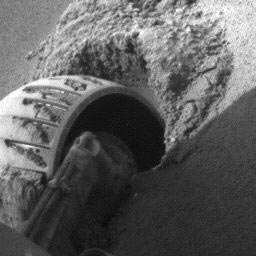

Meanwhile the Air Force had a continuing interest in smaller systems with more rapid turn-around times, and were involved in their own spaceplane project called Dynasoar. In several instances groups from both worked together to investigate the state of the art.
Image : Opportunity's left front wheel. Image credit: NASA/JPL.

NASA's Rovers Continue Martian Missions 05.24.05 -- NASA's Mars rover Opportunity is trying to escape from a sand trap, while its twin, Spirit, has been busy finding new clues to a wet and violent early Martian history.
International Space Station
International Space Station Continuing on from the United States' Skylab and Russia's Mir, the International Space Station (ISS) represents a permanent human presence in space. The space station is located in orbit around the Earth at an altitude of approximately 386 km, a type of orbit usually termed low Earth orbit. (The actual height varies over time by several kilometres due to atmospheric drag and reboosts.) It orbits Earth at a period of about 92 minutes; on December 1, 2003 it had completed over 28,700 orbits since launch. It is serviced primarily by the Space Shuttle, and Soyuz and Progress spacecraft units. It is still being built, but is home to some experimentation already. At present, the station has a capacity for a crew of three, who
John Glenn
and politician. John Glenn during the Mercury program 1962 (NASA) Born in Cambridge, Ohio, he obtained a BS in Engineering from Muskingum College. He enrolled in the Naval Aviation Cadet Program in 1942, and was assigned to the Marines VMO-155 group in 1944. Glenn flew a Corsair over the Marshall Islands, specifically Maloelap, where he was tasked with attacking anti-aircraft gunnery and ground bombardment. By 1945, he was transferred to the Patuxent River Test Pilot School, where he became a test pilot and was promoted to Captain by the war's end. After the war, Glenn flew patrol missions in North China, based in Guam, but in 1948 he became an flight instructor at Corpus Christi, Texas, then undertook an amphibious warfare course and was assigned a staff assignment, all the while
X-Prize
two weeks. This must be essentially the same vehicle: propellant can be replaced, but most of the rest of the vehicle must be reused. Even NASA's space shuttle falls short of this performance requirement, since it takes much more than two weeks to ready a given shuttle between flights. This prize foundation was created to encourage the development of private space travel, which is why government-funded projects are not allowed. The X Prize is designed to help create a space industry, and is modeled after many prizes from the early 20th century that helped prod the development of air flight—notably the $25,000 Orteig Prize that spurred Charles Lindbergh to make his solo flight across the Atlantic Ocean. The X-Prize Foundation (based in St. Louis, Missouri) maintains a list of organizations registered
Canadian space program
Canadian space program Canada has contributed expertise and personnel to the world space effort, especially in collaboration with NASA. Eight Canadians have participated on 11 NASA missions to date: Name Shuttle Mission Launch Date Notes Marc Garneau Challenger STS-41-G October 5, 1984 First Canadian in space Roberta Bondar Discovery STS-42 January 22, 1992 First Canadian woman in space Steven G. MacLean Columbia STS-52 October 22, 1992 Chris Hadfield Atlantis STS-74 November 12, 1995 Marc Garneau Endeavour STS-77 May 19, 1996 Robert Thirsk Columbia STS-78 June 20, 1996 Bjarni Tryggvason Discovery STS-85 August 7, 1997 Dafydd Rhys Williams Columbia STS-90 April 17, 1998 Julie Payette Discovery STS-96 May 27, 1999 Marc Garneau Endeavour STS-97 November 30, 2000 Chris Hadfield Endeavour STS-100 April 19, 2001 First spacewalk by a
NASA's Space Shuttle program is an ongoing endeavor, started in the late 1960s, that has created the world's first partially reusable space launch system, and the first spacecraft capable of carrying large satellites both to and from low Earth orbit. Each shuttle is designed for a projected lifespan of 100 launches. The original purpose of the program was to ferry supplies to a space station. In reality, the Shuttle is the United States' sole manned launch vehicle and has totally dominated NASA's operations since the mid 1970s. With the construction of the International Space Station the Shuttle has finally begun to be used for its original purpose. In January 2004, it was announced that the Shuttle fleet would be replaced by 2010.